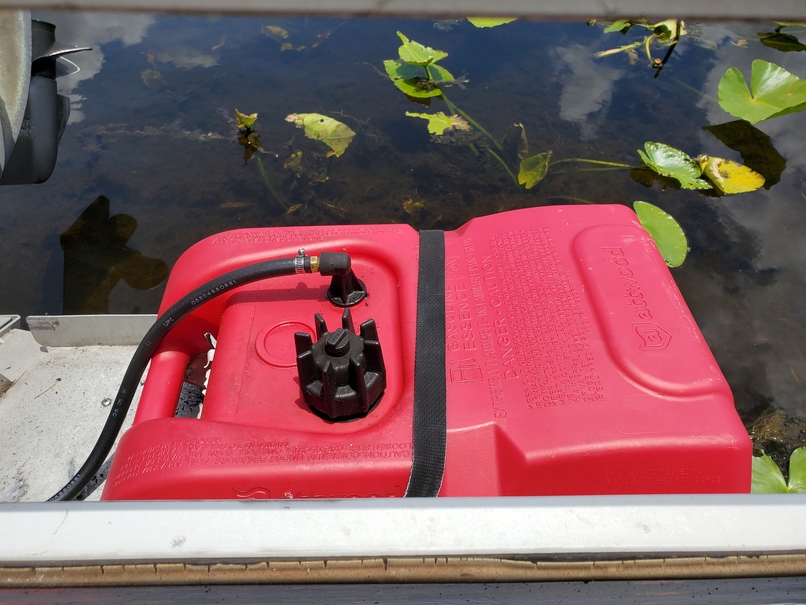If you’re interested in pontoon boats, you need to know how much fuel you’re going to use, so you don’t run out of fuel in the middle of the water.
The pontoon boat gas tank size depends on the boat’s model and size, and in this article, we’ll discuss this topic in detail. So, keep on reading.
What’s A Pontoon Boat Gas Tank Size?
Pontoon boats have tanks that can hold between 10 and 60 gallons of fuel, depending on the size. But on average, a boat’s gas tank will hold about 30 gallons of fuel. Most pontoon boat brands allow owners to customize their boats according to their needs, so they can install a bigger gas tank if they want to.
Pontoon boats aren’t the most fuel-efficient because these boats are slower and have a multi-hull design. Compared to other boats that plane on the water’s surface, a pontoon boat needs a powerful engine to push its pontoon through, which means that it will use more fuel. However, compared to a faster motorboat, a pontoon boat will use less fuel.
It’s quite common for a pontoon boat that measures less than 20 feet long to have a 10-gallon fuel tank. At cruising speed between 18 and 25 mph, the pontoon boat will use about 5 gallons of fuel per hour. This means that if the tank can hold up to 30 gallons of fuel, you can go on a 6-hour trip without having to look for a refill.
There are faster pontoon boats, and these ones are usually bigger with more powerful engines. The maximum speed can reach up to 60 or 65 mph on these boats, so they need bigger fuel tanks to accommodate more fuel.
Since a pontoon boat isn’t meant for speeding, most manufacturers would install a small tank that doesn’t really cover the boater’s needs. However, it’s quite common for pontoon boat owners to look for an upgrade or add an extra tank to hold more fuel.
What Kind of Fuel Does a Pontoon Boat Use?
Most pontoon boats have outboard motors to push the boat through the water, and the bigger the boat, the more powerful the engine should be. To operate the engine, you need to use unleaded fuel like the one that you would use in your car.
E10 or 10% ethanol fuel is the maximum that you can use while filling your boat tank because a higher ethanol content can actually damage the motor. This type of fuel also decreases the amount of dangerous emissions. This fuel can last up to 2 months, and you need to keep it in a dry container at a temperature that doesn’t exceed 20 degrees Celsius, so it can stay in good condition.
What Factors Affect Fuel Consumption on Your Pontoon Boat?
In addition to the size of the boat, there are several factors that affect fuel consumption on your pontoon boat.
- The condition and specifications of the engine affect fuel consumption. An older motor will be less fuel-efficient, and this means that you’ll have to refill the tank more often.
- The amount of fuel used depends on the speed you choose. If you decide to push your pontoon boat at a higher speed, you can expect to run out of fuel faster. However, the maximum speed is determined by the engine’s horsepower.
- The weight you carry on your pontoon boat will slow it down. If you want to maintain the same speed, your motor will have to exert more effort, and this means that it will use more fuel.
- The maintenance of your boat plays a crucial role in fuel consumption. For example, if algae cover the tubes, your boat will be slower and will need more fuel to maintain its speed.
How Can You Save Fuel Consumption On Your Pontoon Boat?
There are several tips that you can follow to get more mileage from your fuel and save on consumption.
- Maintain the boat’s engine and keep it in good condition. Cleaning the engine and repairing any broken parts guarantees that it will perform well, so it doesn’t waste fuel. You should also tune up the propeller for the best performance.
- Try to reduce drag by removing the excess weight. Think of the number of passengers on your boat and ask them to pack smartly for a trip. If you have to carry a lot of weight, make sure that it’s evenly distributed across the deck.
- Think of where you’re getting your fuel. Picking the right type of fuel will have a huge impact on your boat’s speed and the overall performance of your engine.
- Find the sweet spot for your boat. This refers to the optimum fuel consumption while maintaining an adequate speed.
- Make the necessary modifications to your boat for better performance. For example, you can get rid of the Bimini top if the weather isn’t that hot. Although this top protects your deck from sun damage, the metal frame adds unnecessary weight and resistance that affect fuel consumption.
Where Can You Get Fuel For Your Pontoon Boat?
You can get fuel from the marina or your regular service station. The service station will sell the same type of fuel, but it will be more affordable. Just make sure that you’re picking the right type of fuel for your pontoon boat.
Wrap Up
A pontoon boat usually has a tank that can hold up to 30 gallons of fuel. Smaller boats can have smaller tanks that hold 10 gallons of fuel, while the larger ones can have bigger tanks that hold up to 60 gallons of fuel.
Most boat owners usually choose to upgrade their fuel tanks or to add other tanks to hold more fuel. However, on average, at cruising speed, you can take your pontoon boat for a 5 or 6-hour cruising trip without looking for a tank refill.

